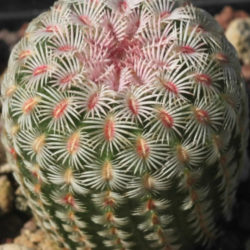Scientific Name
Echinocereus rigidissimus (Engelm.) F.Haage
Common Name(s)
Arizona Rainbow Cactus, Rainbow Hedgehog Cactus, Sonoran Rainbow Cactus
Synonym(s)
Cereus pectinatus var. rigidissimus, Echinocereus dasyacanthus var. rigidissimus, Echinocereus pectinatus var. rigidissimus, Echinocereus rigidissimus subsp. rigidissimus
Scientific Classification
Family: Cactaceae
Subfamily: Cactoideae
Tribe: Pachycereeae
Genus: Echinocereus
Description
Echinocereus rigidissimus is a beautiful small cactus with an erect, short cylindrical, usually solitary stem with 15 to 26 ribs lines with clusters of pectinately arranged spines straight or slightly curved toward the stem. The stem can grow up to 12 inches (30 cm) tall and 4.4 inches (11 cm) in diameter. The spines are up to 0.4 inches (1 cm) long, initially reddish to magenta, and become yellow or light pink as they mature. Each areole bears 16 to 22 radial spines. The central spines are absent.
The showy flowers are bright rose-pink or magenta with a white throat and appear at the top of the stem in late spring. They are funnel-shaped and can reach up to 3.2 inches (8 cm) in length and 3.6 inches (9 cm) in diameter. The spiny fruits are spherical, greenish to dark purplish-brown, and contain white pulp and dark brown to black seeds.
Origin
Echinocereus rigidissimus is native to Mexico (Chihuahua and Sonora) and the United States (Arizona and New Mexico).
Etymology
The specific epithet "rigidissimus (rig-id-ISS-ih-mus)" means "very rigid, most rigid" and refers to the stiff spines.

Hardiness
USDA hardiness zones 9a to 11b: from 20 °F (−6.7 °C) to 50 °F (+10 °C).
How to Grow and Care
If you can grow other globular cactus successfully, you can most likely grow Echinocereus well. One of the key factors in success with these is avoiding any hint of wet soil. Because their root systems are weak, they are especially prone to root rot, eventually killing your plant. Otherwise, they thrive on a program of intense, bright light, slight water, and a steady diet of light fertilizer. These cacti are vulnerable to mealybugs and aphids.
Echinocereus are slow-growing cacti that should only need repotting every other year or so. You can prolong the time to repotting by removing plantlets and potting them up in their own pots. When repotting a cactus, remove it from its pot and remove any clumped soil. These plants tend to be shallow-rooted with weak root systems, so take care not to damage their roots.
Learn more at How to Grow and Care for Echinocereus.
Subspecies and Forms
- Echinocereus rigidissimus subsp. rubispinus
- Echinocereus rigidissimus subsp. rubispinus 'Albiflorus'
Links
- Back to genus Echinocereus
- Succupedia: Browse succulents by Scientific Name, Common Name, Genus, Family, USDA Hardiness Zone, Origin, or cacti by Genus
Photo Gallery
Click on a photo to see a larger version.


